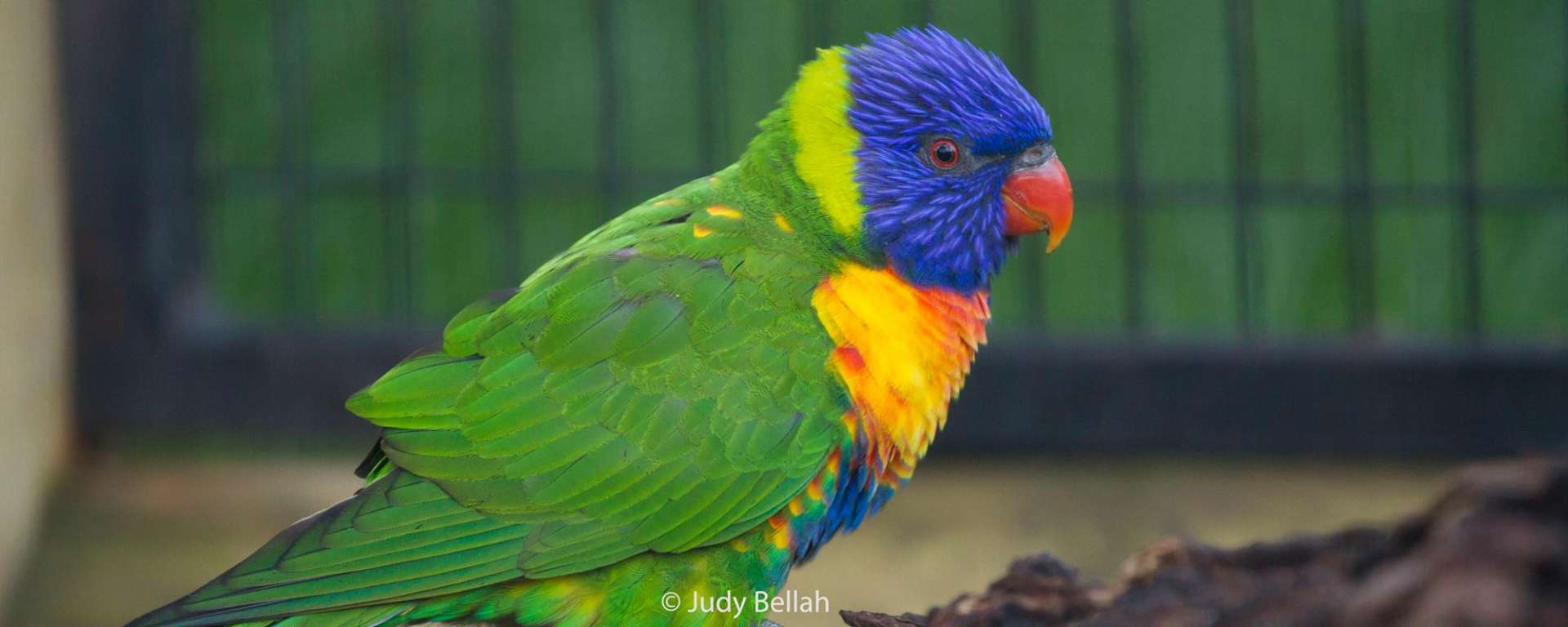Description
The Rainbow Lorikeet is a true parrot, a member of the Psittaciformes species. They are extremely brightly colored: the head is bright blue, the collar is greenish- yellow and the back, wings tail and thighs are green. The chest is orange-yellow and the belly dark blue. When they fly the yellow wing bar contrasts with the red coverts (small feathers that cover the wing quills). Males and females look very similar. Juveniles have a black beak that gradually turns into the orangey red adult color.
Classification
- Class
- Aves
- Order
- Psittaciformes
- Family
- Psittacidae
- Genus
- Trichoglossus
- Species
- T. moluccanus
- Conservation Status
- Least Concern
Key Facts
- Length
- 25-30 centimeters (10-12 inches)
- Weight
- 75-150 grams (2.5-5.5 ounces)
Social Life: Rainbow lorikeets are usually found as a pair, although they sometimes flock together. Pairs vigorously defend their nest against other lorikeets and other bird species. Rainbows are mostly monogamous and remained paired for most if not all their life.
Habitat and Range: The Rainbow Lorikeet is native to the eastern part of Australia; they live in woodland areas including rainforests. They have been introduced to Western Australia, New Zealand, Tasmania and Hong Kong. They can range as far as 40 miles in search of food but are usually sedentary.
Diet: Rainbow lorikeets eat fruit, pollen and nectar. Eucalyptus trees provide a good source of food. Lorikeets have specially adapted tongues with papillae, small nipple-like structures that give the tongue a rough texture.
Lifespan: Rainbow Lorikeets frequently live 15 to 20 years.
Predators: Predators include snakes and birds of prey. Lorikeets give a loud alarm call to warn of predators nearby.
Reproduction: Lorikeet breeding season varies based on food supply and climate. Males have a number of courtship dances that include bobbing and vocalizing for the female. Nests are usually in the hollows of trees. The female lays one to three eggs and incubates them for about 25 days. Both parents care for the chicks after they hatch. Chicks fledge at about 60 days.
- Information
-
Description
The Rainbow Lorikeet is a true parrot, a member of the Psittaciformes species. They are extremely brightly colored: the head is bright blue, the collar is greenish- yellow and the back, wings tail and thighs are green. The chest is orange-yellow and the belly dark blue. When they fly the yellow wing bar contrasts with the red coverts (small feathers that cover the wing quills). Males and females look very similar. Juveniles have a black beak that gradually turns into the orangey red adult color.
Classification
- Class
- Aves
- Order
- Psittaciformes
- Family
- Psittacidae
- Genus
- Trichoglossus
- Species
- T. moluccanus
- Conservation Status
- Least Concern
Key Facts
- Length
- 25-30 centimeters (10-12 inches)
- Weight
- 75-150 grams (2.5-5.5 ounces)
- Lifestyle
Social Life: Rainbow lorikeets are usually found as a pair, although they sometimes flock together. Pairs vigorously defend their nest against other lorikeets and other bird species. Rainbows are mostly monogamous and remained paired for most if not all their life.
Habitat and Range: The Rainbow Lorikeet is native to the eastern part of Australia; they live in woodland areas including rainforests. They have been introduced to Western Australia, New Zealand, Tasmania and Hong Kong. They can range as far as 40 miles in search of food but are usually sedentary.
Diet: Rainbow lorikeets eat fruit, pollen and nectar. Eucalyptus trees provide a good source of food. Lorikeets have specially adapted tongues with papillae, small nipple-like structures that give the tongue a rough texture.
Lifespan: Rainbow Lorikeets frequently live 15 to 20 years.
Predators: Predators include snakes and birds of prey. Lorikeets give a loud alarm call to warn of predators nearby.
Reproduction: Lorikeet breeding season varies based on food supply and climate. Males have a number of courtship dances that include bobbing and vocalizing for the female. Nests are usually in the hollows of trees. The female lays one to three eggs and incubates them for about 25 days. Both parents care for the chicks after they hatch. Chicks fledge at about 60 days.

